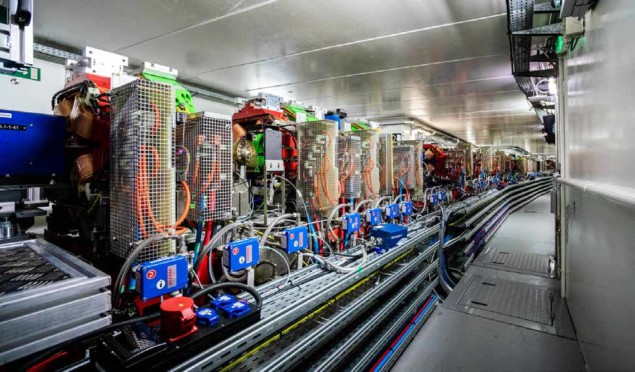
Officials at the European Synchrotron Radiation Facility (ESRF) in Grenoble, France, have announced the completion of a major upgrade to one of Europe’s premier X-ray facilities. Dubbed the Extremely Brilliant Source, or ESRF-EBS, the revamp boosts the brilliance and coherence of the X-ray beams at the facility by around a factor of 100 over its predecessor, allowing the structure of matter at the atomic level to be studied much faster and in greater detail than before. The first users are expected to start using the machine when it officially begins operation on 25 August.
Since opening in 1992, the original ESRF storage ring was the most powerful synchrotron radiation source in Europe, providing intense beams of X-rays that were used each year by more than 6000 visiting scientists in a variety of disciplines from condensed-matter physics to protein crystallography.
In December 2018 the ESRF closed to allow construction work on the ESRF-EBS. The upgrade involved replacing the entire 350 m-diameter storage ring, which accelerates the electrons in a circular path where they emit X-rays that are then used by researchers. This involved installing seven “bending” magnets as well as a brand-new device — the Hybrid Multi-Bend Achromat — that allows the production of an electron beam with a much smaller “emittance” than before. The new beam will be 2 micrometres high and 20 micrometres wide — compared to around 250 micrometres wide in the previous beam.
Within budget
After the first electrons were injected into the new machine last year, engineers first optimized the parameters of the beam, ramped up the current and used the beam to condition the storage ring vacuum system. Early this year, the ESRF put out a call for proposal to use the new machine. According to Harald Reichert, director of research at the ESRF, 1238 proposals were submitted, of which around a third were granted. Work at the facility in the coming months and year is expected include mapping the human brain at the synapse level, tracking nanoparticles in soil samples as well as following lithium atoms during battery cycling.

A bright light in the Alps
Francesco Sette, director-general of the ESRF, says that the EBS has been delivered within budget and well within schedule. “This is a moment of pride for the whole of the synchrotron community,” says Sette. “With the opening of this brand-new generation of high-energy synchrotron, the ESRF continues its pioneering role to provide an unprecedented new tool for scientists to push the frontiers of science and address vital challenges facing our society today, such as health, and the environment. ”
The new facility has already been operational since March, and from April has been used to study the SARS-CoV-2 virus that is responsible for the COVID-19 pandemic. This has involved examining the molecular structure of the virus as well as imaging organs impacted by the disease.
